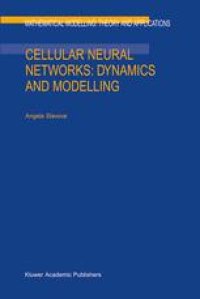
Ebook: Cellular Neural Networks: Dynamics and Modelling
Author: Angela Slavova (auth.)
- Tags: Statistical Physics Dynamical Systems and Complexity, Mathematical Modeling and Industrial Mathematics, Ordinary Differential Equations, Partial Differential Equations, Neurosciences
- Series: Mathematical Modelling: Theory and Applications 16
- Year: 2003
- Publisher: Springer Netherlands
- Edition: 1
- Language: English
- pdf
Conventional digital computation methods have run into a se rious speed bottleneck due to their serial nature. To overcome this problem, a new computation model, called Neural Networks, has been proposed, which is based on some aspects of neurobiology and adapted to integrated circuits. The increased availability of com puting power has not only made many new applications possible but has also created the desire to perform cognitive tasks which are easily carried out by the human brain. It become obvious that new types of algorithms and/or circuits were necessary to cope with such tasks. Inspiration has been sought from the functioning of the hu man brain, which led to the artificial neural network approach. One way of looking at neural networks is to consider them to be arrays of nonlinear dynamical systems that interact with each other. This book deals with one class of locally coupled neural net works, called Cellular Neural Networks (CNNs). CNNs were intro duced in 1988 by L. O. Chua and L. Yang [27,28] as a novel class of information processing systems, which posseses some of the key fea tures of neural networks (NNs) and which has important potential applications in such areas as image processing and pattern reco gnition. Unfortunately, the highly interdisciplinary nature of the research in CNNs makes it very difficult for a newcomer to enter this important and fasciriating area of modern science.
This book deals with new theoretical results for studying Cellular Neural Networks (CNNs) concerning its dynamical behavior. New aspects of CNNs' applications are developed for modelling of some famous nonlinear partial differential equations arising in biology, genetics, neurophysiology, physics, ecology, etc. The analysis of CNNs' models is based on the harmonic balance method well known in control theory and in the study of electronic oscillators. Such phenomena as hysteresis, bifurcation and chaos are studied for CNNs.
The topics investigated in the book involve several scientific disciplines, such as dynamical systems, applied mathematics, mathematical modelling, information processing, biology and neurophysiology. The reader will find comprehensive discussion on the subject as well as rigorous mathematical analyses of networks of neurons from the view point of dynamical systems. The text is written as a textbook for senior undergraduate and graduate students in applied mathematics. Providing a summary of recent results on dynamics and modelling of CNNs, the book will also be of interest to all researchers in the area.
This book deals with new theoretical results for studying Cellular Neural Networks (CNNs) concerning its dynamical behavior. New aspects of CNNs' applications are developed for modelling of some famous nonlinear partial differential equations arising in biology, genetics, neurophysiology, physics, ecology, etc. The analysis of CNNs' models is based on the harmonic balance method well known in control theory and in the study of electronic oscillators. Such phenomena as hysteresis, bifurcation and chaos are studied for CNNs.
The topics investigated in the book involve several scientific disciplines, such as dynamical systems, applied mathematics, mathematical modelling, information processing, biology and neurophysiology. The reader will find comprehensive discussion on the subject as well as rigorous mathematical analyses of networks of neurons from the view point of dynamical systems. The text is written as a textbook for senior undergraduate and graduate students in applied mathematics. Providing a summary of recent results on dynamics and modelling of CNNs, the book will also be of interest to all researchers in the area.
Content:
Front Matter....Pages i-x
Basic theory about CNNs....Pages 1-48
Dynamics of nonlinear and delay CNNs....Pages 49-84
Hysteresis and Chaos in CNNs....Pages 85-118
CNN modelling in biology, physics and ecology....Pages 118-167
Appendix A. Topological degree method....Pages 168-174
Appendix B. Hysteresis and its models....Pages 175-188
Appendix C. Describing function method and its application for analysis of Cellular Neural Networks....Pages 189-202
Back Matter....Pages 203-220
This book deals with new theoretical results for studying Cellular Neural Networks (CNNs) concerning its dynamical behavior. New aspects of CNNs' applications are developed for modelling of some famous nonlinear partial differential equations arising in biology, genetics, neurophysiology, physics, ecology, etc. The analysis of CNNs' models is based on the harmonic balance method well known in control theory and in the study of electronic oscillators. Such phenomena as hysteresis, bifurcation and chaos are studied for CNNs.
The topics investigated in the book involve several scientific disciplines, such as dynamical systems, applied mathematics, mathematical modelling, information processing, biology and neurophysiology. The reader will find comprehensive discussion on the subject as well as rigorous mathematical analyses of networks of neurons from the view point of dynamical systems. The text is written as a textbook for senior undergraduate and graduate students in applied mathematics. Providing a summary of recent results on dynamics and modelling of CNNs, the book will also be of interest to all researchers in the area.
Content:
Front Matter....Pages i-x
Basic theory about CNNs....Pages 1-48
Dynamics of nonlinear and delay CNNs....Pages 49-84
Hysteresis and Chaos in CNNs....Pages 85-118
CNN modelling in biology, physics and ecology....Pages 118-167
Appendix A. Topological degree method....Pages 168-174
Appendix B. Hysteresis and its models....Pages 175-188
Appendix C. Describing function method and its application for analysis of Cellular Neural Networks....Pages 189-202
Back Matter....Pages 203-220
....